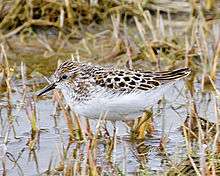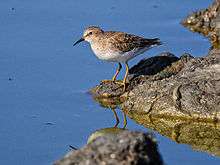Least sandpiper
| Least sandpiper | |
|---|---|
 | |
| Summer plumage | |
 | |
| Winter plumage | |
| Scientific classification | |
| Kingdom: | Animalia |
| Phylum: | Chordata |
| Class: | Aves |
| Order: | Charadriiformes |
| Family: | Scolopacidae |
| Genus: | Calidris |
| Species: | C. minutilla |
| Binomial name | |
| Calidris minutilla Vieillot, 1819 | |
| Synonyms | |
|
Erolia minutilla | |
The least sandpiper (Calidris minutilla) is the smallest shorebird. The genus name is from Ancient Greek kalidris or skalidris, a term used by Aristotle for some grey-coloured waterside birds. The specific minutilla is Medieval Latin for "very small".[2]
Description
This species has greenish legs and a short, thin, dark bill. Breeding adults are brown with dark brown streaks on top and white underneath. They have a light line above the eye and a dark crown. In winter, Least sandpipers are grey above. The juveniles are brightly patterned above with rufous colouration and white mantle stripes.
This bird can be difficult to distinguish from other similar tiny shorebirds; these are known collectively as "peeps" or "stints". In particular, least sandpiper is very similar to its Asian counterpart, long-toed stint. It differs from that species in its more compact, shorter-necked appearance, shorter toes, somewhat duller colours, and stronger wingbar.
Breeding and migration
Their breeding habitat is the northern North American continent on tundra or in bogs. They nest on the ground near water. The female lays four eggs in a shallow scrape lined with grass and moss. Both parents incubate; the female leaves before the young birds fledge and sometimes before the eggs hatch. The young birds feed themselves and are able to fly within two weeks of birth.
They migrate in flocks to the southern United States, Mexico, Central America, the Caribbean, and northern South America. They occur as very rare vagrants in western Europe.[3]
Feeding
These birds forage on mudflats, picking up food by sight, sometimes by probing. They mainly eat small crustaceans, insects, and snails.
References
- ↑ BirdLife International (2012). "Calidris minutilla". IUCN Red List of Threatened Species. Version 2013.2. International Union for Conservation of Nature. Retrieved 26 November 2013.
- ↑ Jobling, James A (2010). The Helm Dictionary of Scientific Bird Names. London: Christopher Helm. pp. 84, 256. ISBN 978-1-4081-2501-4.
- ↑ Harrison, Graham; Harrison, Janet (2005). The New Birds of the West Midlands. West Midland Bird Club. ISBN 0-9507881-2-0. Archived from the original on 23 January 2009.
Further reading
Identification
- Jonsson, Lars & Peter J. Grant (1984) Identification of stints and peeps British Birds 77(7):293-315
External links
| Wikimedia Commons has media related to Least Sandpiper. |
| Wikispecies has information related to: Calidris minutilla |
- An online identification article covering this species and other small calidrids at surfbirds.com
- Least sandpiper species account - Cornell Lab of Ornithology
- Least sandpiper - Calidris minutilla - USGS Patuxent Bird Identification InfoCenter
- Least sandpiper photos at Oiseaux.net
- "Least sandpiper media". Internet Bird Collection.
- Least sandpiper photo gallery at VIREO (Drexel University)
- Interactive range map of Calidris minutilla at IUCN Red List maps
